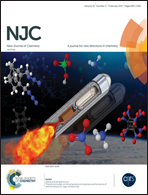Glyoxalbis(2-methylmercaptoanil) complexes of nickel and ruthenium: radical versus non-radical states†
Abstract
The coordination chemistry of a N2S2 donor α-diimine ligand, glyoxalbis(2-methylmercaptoanil) (gmma), with transition metal ions was explored. The study authenticated that gmma is a redox non-innocent flexidentate ligand. The nickel(II) and ruthenium(II) complexes of types trans-[NiII(gmma)Cl2] (1), trans-[RuII(gmma)Cl2] (2) and [RuII(gmma)(PPh3)Cl]Cl (3+Cl−) were isolated. Single crystal X-ray crystallography established that the diimine fragment particularly in 2 and 3+Cl−·H2O is severely distorted. EPR spectroscopy and density functional theory (DFT) calculations authenticated that the octahedral 1− and 12− ions are the gmma anion radical (gmma˙−) and gmma diimide (gmma2−) complexes of types trans-[NiII(gmma˙−)Cl2]− (1−) and trans-[NiII(gmma2−)Cl2]2− (12−) which are unstable in solution. The chemically and electrochemically reduced ions undergo a chemical change to a dinuclear square planar nickel(II) complex of type [(μ-NSNS-gmma)Ni2Cl3(PF6)] (4PF6) in the presence of PF6− salt, predicted by ESI mass spectroscopy, where μ-NSNS-gmma is a bis(methylthio-imine) donor bridging ligand. The CSS solution of 2 is stable. In contrast to 1− and 12− ions, 2− in solution does not undergo any chemical change and it is defined as a resonance hybrid of trans-[RuII(gmma˙−)Cl2]− and trans-[RuIII(gmma2−)Cl2]− states. Similarly, 3 is defined as a resonance hybrid of [RuII(gmma˙−)(PPh3)Cl] and [RuIII(gmma2−)(PPh3)Cl] states. In 2− and 3 the atomic spin is delocalised over both ruthenium and the α-diimine fragment, authenticated by the unrestricted DFT calculations. The UV-vis absorption spectra of the isolated complexes and their reduced analogues were analyzed by spectroelectrochemical measurements and TD DFT calculations.



 Please wait while we load your content...
Please wait while we load your content...